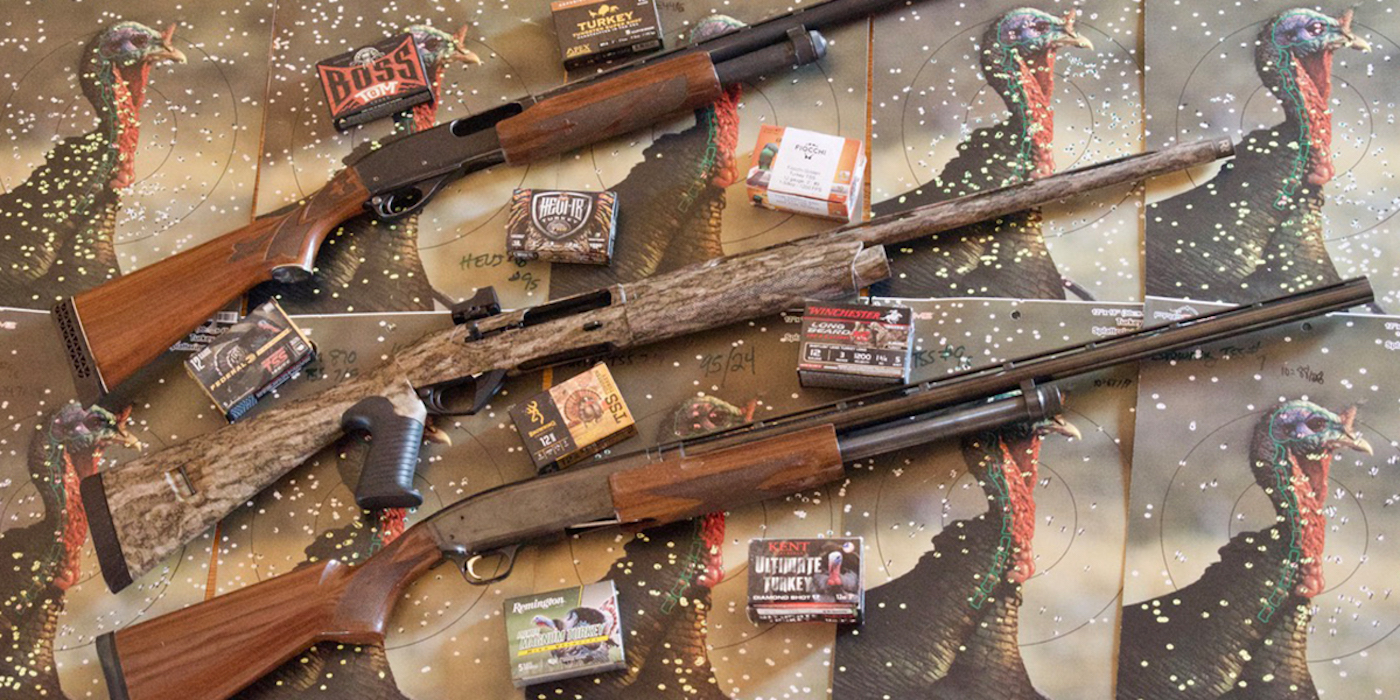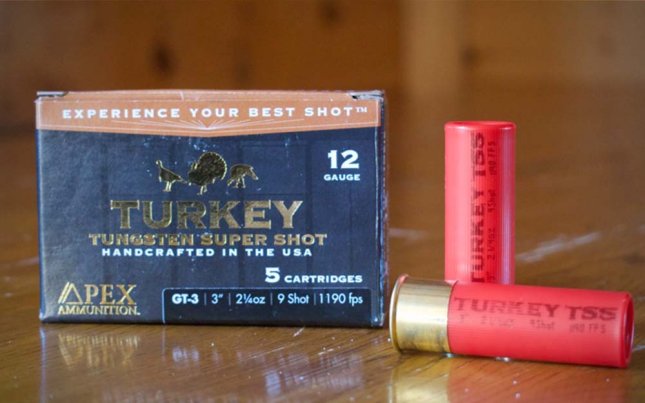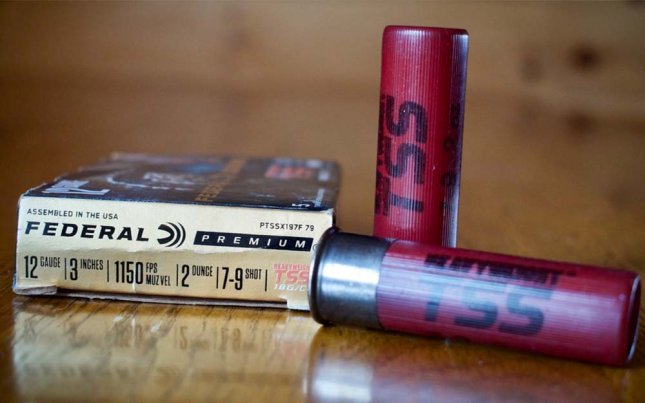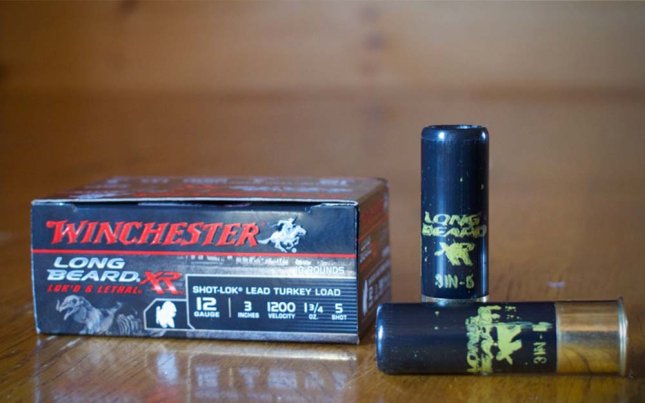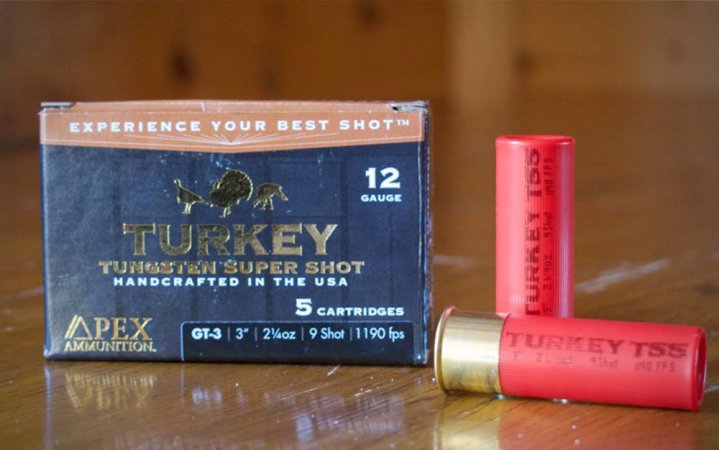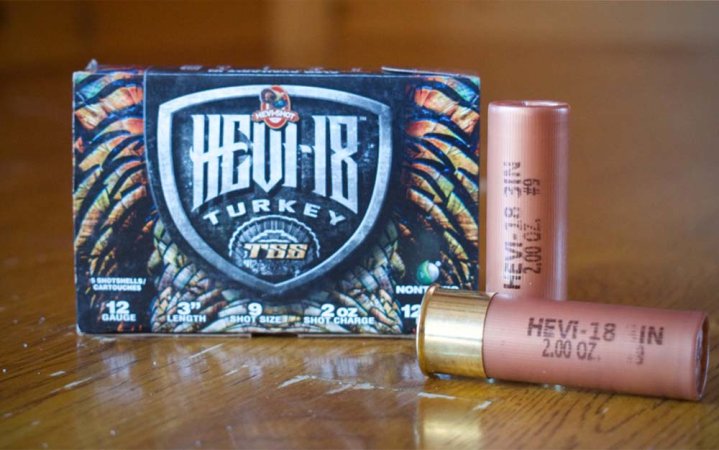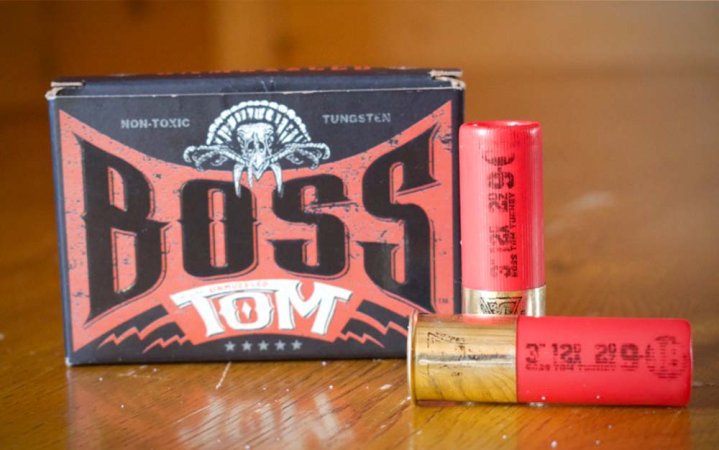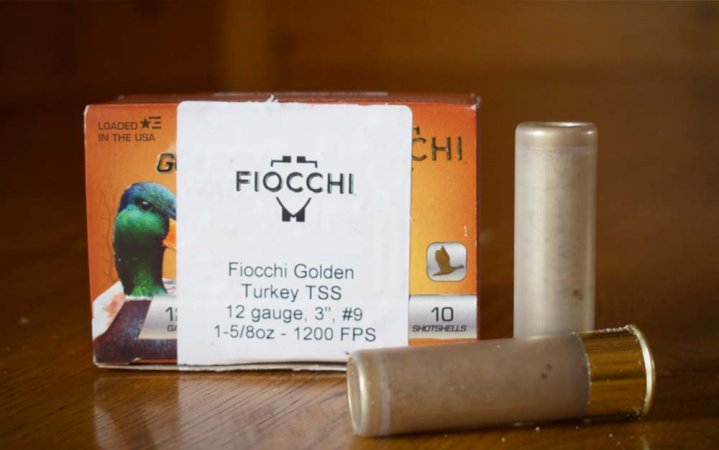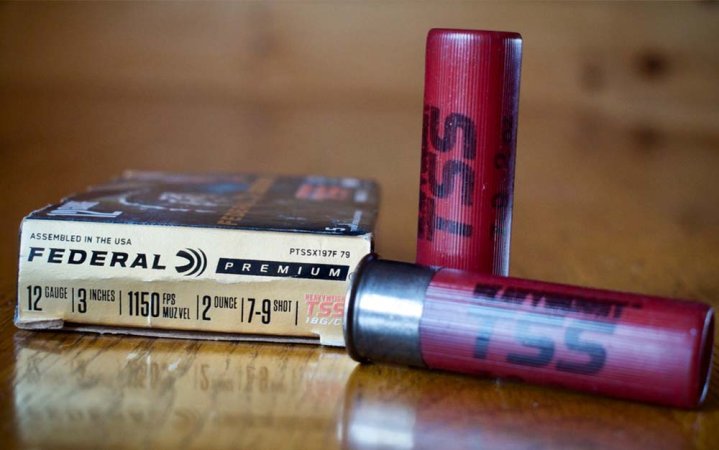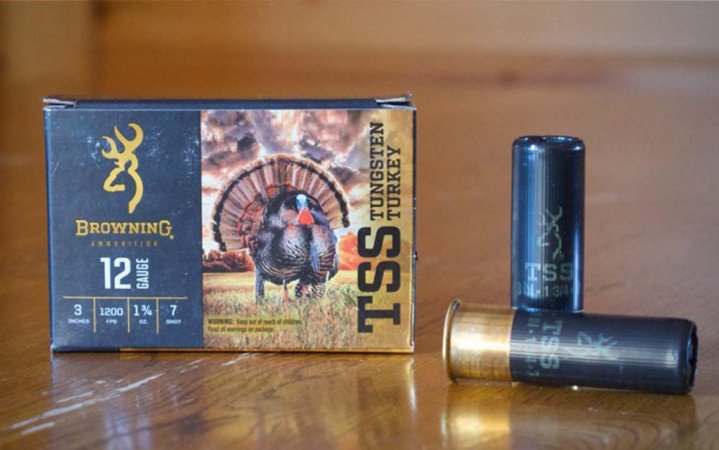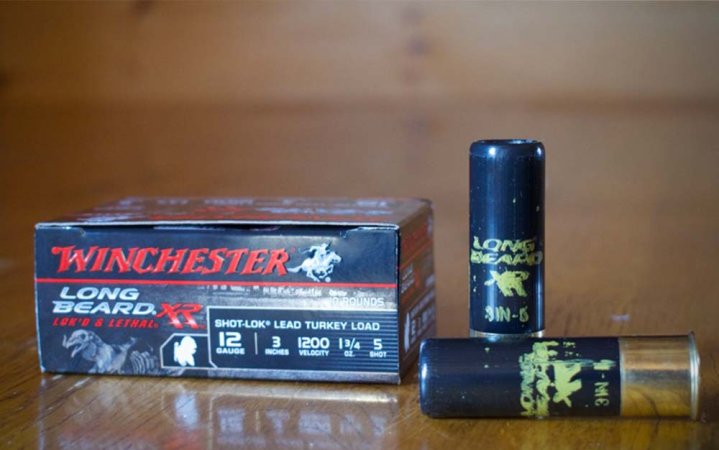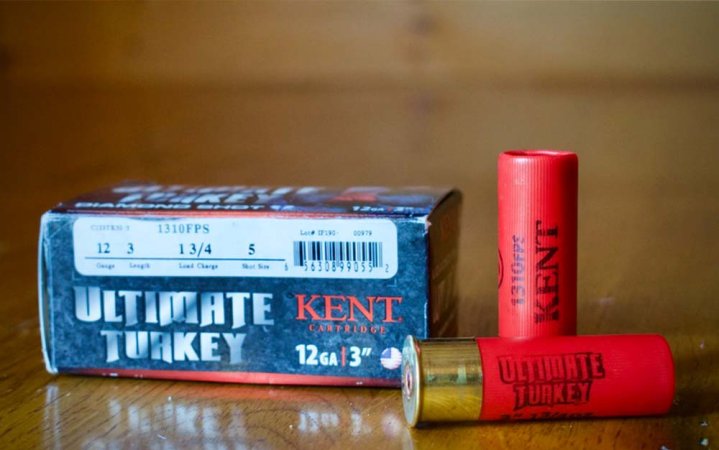We may earn revenue from the products available on this page and participate in affiliate programs. Learn More ›
If it weren’t for the lead shot ban in 1991, the evolution of shotgun shells would have likely stagnated. When ammo makers moved to steel so duck hunters could continue legally killing puddlers and divers and geese each fall, turkey hunters benefited … eventually. Steel is hard but not dense, and slowly, shotshell manufacturers began to turn to bismuth and tungsten as non-toxic alternatives to steel waterfowl shot. Both metals are denser, thus more effective at killing. As a side effect, TSS (tungsten super shot) became widely popular for turkey loads, because it hits harder, and patterns better than any other birdshot in production. But, having a hull full of TSS doesn’t mean a turkey load is going to be great. So to separate the good from the great, associate gear editor Adam Moore and I spent a few days shooting every turkey load we could get our hands on to see how they patterned, penetrated, and to check their speed. After some intensive testing, here’s our list of the best turkey loads out there.
- Best Overall Pattern: Apex GT-3 TSS 3-inch, 2¼-ounce, No. 9
- Most Consistent Pattern: Hevi-18 TSS 3-inch, 2-ounce, No. 9
- Tightest Pattern at 40 Yards: Boss 3-inch, 2-ounce, No. 9
- Best TSS Pattern Percentage: Fiocchi Golden Turkey TSS 3-inch, 1 5/8-ounce, No.9
- Best Long-Range Pattern: Federal Heavyweight TSS 3-inch, 2-ounce No. 7/9
- Best TSS Penetration: Browning TSS 3-inch, 1¾-ounce, No. 7
- Best Lead Load: Winchester Longbeard XR 3-inch, 1¾-ounce, No. 5
- Best Lead Shot Penetration: Remington Magnum Turkey 3.5-inch, 2-ounce, No. 5
- Best Shotshell for Beginners: Kent Ultimate Turkey 3-inch, 1¾-ounce, No. 5
- Best .410 Overall: Apex Ninja
- Best .410 Availability: Federal Heavyweight
TSS vs. Lead Turkey Loads
Hevi-Shot was one of the first ammo makers to employ tungsten in its turkey loads (handloaders used it for some time before mass shotshell production began). They used a combination of tungsten and iron to create a pellet with a density of 12 grams per cubic centimeter (g/cc), which is slightly higher than the 11 g/cc density of lead. Since then, more large ammo manufacturers have produced TSS loads, which are not pure tungsten, but rather a mix of 95 percent tungsten and 5 percent nickel and iron powder. TSS has a density of 18 g/cc, which is more than twice the density of steel. Because TSS is so dense, you can load smaller and therefore more pellets of it in a hull. For instance, No. 9 TSS has about the same mass as a lead No. 5 pellet. But there are around 360 pellets per ounce in a load of No. 9 TSS compared to 175 for a lead 5. So, you can see why TSS packs a more potent punch.
TSS is also expensive. A box of five 2-ounce turkey loads can run upwards of $60, which is why plenty of turkey hunters still stick with lead. And that’s just fine. Because many lead loads can kill turkeys out to 40 yards if choked and patterned properly. They also cost one-third the price of TSS. If you shoot most of your turkeys inside 40 yards, there might never be a reason to buy TSS. Field & Stream shotgun editor Phil Bourjaily tested TSS against lead loads in 2021, if you want to see how potent lead is at shorter yardages.
To find out which of today’s turkey loads most effectively kill gobblers, associate editor Adam Moore and I recently tested nine popular lead and TSS shotshells. Here are the results.
How We Tested the Best Turkey Loads
Pattern
To start, we patterned nine different 12-gauge shotshells at 40 yards on a 10-inch Birchwood-Casey Reactive Turkey Target through three different shotguns: a Benelli Super Black Eagle 3 Performance Shop (.655 Rob Roberts Final Strut choke), Remington 870 (Primos Tight Wad choke), and Browning BPS (standard Invector Plus full choke).

Before tabulating pellet strikes, we first found the hold point on the target for best pattern results. For instance, the SBE3 has a Burris FastFire II red-dot, so we put that dot right on the turkey’s head at 40 and pulled the trigger to deliver an optimal pattern. The 870 had a mid-neck hold point, and the BPS patterned best when I held it at the base of the turkey’s neck and slightly to the right.
Penetration
Then we moved on to the penetration portion of our best turkey loads test, shooting each load from 40 yards into a penetration box modeled after one former Field & Stream shooting editor Bob Brister designed decades ago. The wooden box, built by my stepdad and his brother, is roughly four feet long with an 18- by 18-inch opening. There are 27 slots spaced 1½ inches apart inside the box, each of which holds a 1/8-inch-thick piece of cardboard.

I also placed a ½-inch piece of drywall just behind the first piece of cardboard before each shot. This helped slow the pellets. Each load would have simply blown through all 27 cardboard slats without it. If the load penetrated the drywall at 40 yards, that also was a good sign it could kill a turkey. After the drywall and cardboard were in place, I shot into the opening of the box using the 870 (of the three guns, it patterned best) to see how many pieces of cardboard each load could penetrate.
Read Next: Best Turkey Shotguns of 2023
Velocity
Finally, we tested each shotshell for muzzle velocity by shooting through a chronograph. In my experience, shotshells don’t replicate the velocity stamped on the ammo box. So, I shot each shell up to five times and recorded the best result. I did this because 1) I was relying on a machine (chronograph) to supply accurate data in pretty brutal conditions (it was 20°F with a 25 mph north wind), and 2) not every shotshell always gets the same amount of gunpowder or burns at the same rate, no matter how conscientious ammo makers are about loading shells. There’s always going to be some slight variance.
Best Turkey Loads: Reviews & Recommendations
Best Overall Pattern: Apex GT-3 TSS 3-inch, 2¼-ounce, No. 9
Key Features
- Best Pattern (10-inch circle, 40 yards): 270 pellets
- Best Head/Neck Strikes: 25 pellets
- Brister Box: One pellet through 26 pieces of cardboard
- Muzzle Velocity: 1,488 fps
- Buffered shot
Pros
- Over a 2-ounce payload
- Dense pattern
Cons
- Heavy recoil
- Loud
- Pricey
Apex produced the best pattern of the test, placing 270 No. 9s inside a 10-inch target at 40 yards through the Remington 870. Benelli’s SBE3 put 156 pellets on target and the BPS placed 67 in the circle. One pellet penetrated 26 of 27 cardboard slats in the Brister box, which was the second worst of all the TSS loads (other than Boss, the rest made it through all 27 panels). But that’s still enough energy to kill a longbeard.

The 2¼-ounce payload was the heaviest of the test, and you can feel every bit of it when you pull the trigger. But you also get 814 pellets downrange, which gives you a better chance of getting a pellet in a turkey’s head than any of the other turkey loads tested. Apex lists the muzzle velocity at 1,190 fps, but the chronograph didn’t read lower than 1,300 fps on three different shots, the best being a spicy 1,488 fps, which is comparable to a waterfowl load.
Apex does not crimp its shotshells. Instead, the company places a sealed paper cap at the end, which makes it less likely to hang up in the action as it ejects because there’s no flaring. GT-3 is offered in 10-, 12-, 16-, 20-, and 28-gauge, as well as .410-bore in shot sizes 7.5, 8, 9, and 9.5.
Most Consistent Pattern: Hevi-18 TSS 3-inch, 2-ounce, No. 9
Key Features
- Best Pattern (10-inch circle, 40 yards): 253 pellets
- Best Head/Neck Strikes: 46 pellets
- Brister Box: 22 pellets through 27 pieces of cardboard
- Muzzle Velocity: 1,080 fps
- Buffered shot
Pros
- Second-best TSS pattern percentage: 253 of 714 (35 percent)
- Patterned the most consistent out of all three guns
Cons
- Velocity is lower than advertised
Hevi-18 had the most consistent patterns of the test out of all three turkey shotguns. It placed 253 pellets (46 of which struck the head and neck) inside the 10-inch circle from the 870, followed by 156 (46 head and neck) out of the BPS, and 147 (34 head and neck) from the SBE3. The contents inside the Hevi-18 four-petal wad look much different than any of the other shells. Hevi-18 uses flaxseed at the end of the payload to fill any empty space left in the shell, a common trait in every Hevi-Shot product I’ve ever used.

But the buffering—small polymer balls that look like salt and hinder pellet deformation—is heavy. It was so thick that it covered up most of the pellets once I dumped them into a plastic bag. The 2-ounce payload penetrated 27 pieces of cardboard in the Brister box, which it hit with such authority that the box actually jumped up from the sawhorses it was placed on. The load also put 27 pellets inside the 10-inch circle at 70 yards and penetrated ½-inch drywall, proving it could kill a turkey at that distance. Hevi-18 is offered in 12- and 20- gauge, plus .410-bore in shot sizes 7 and 9.
Tightest Pattern at 40 Yards: Boss 3-inch, 2-ounce, No. 9
Key Features
- Best Pattern (10-inch circle, 40 yards): 250 pellets
- Best Head/Neck Strikes: 60 pellets
- Brister Box: 1 pellet through 21 pieces of cardboard
- Muzzle Velocity: 954 fps
- Copper-plated shot
Pros
- Placed the most pellets in the head and neck of any test load
- Direct to consumer equals lower price
Cons
- Last in penetration among TSS loads
Boss was the only TSS shotshell in our test that did not use a polymer buffer to help with shot fractures. But they do use a rather sizable piece of fiber at the wad’s base to act as a cushion. The recipe clearly works because Boss put the most pellets on the head and neck of our turkey targets, placing 60 No. 9s in the kill zone through the 870.

It also tallied 51 head and neck hits with the SBE3 (also better than any other shell), and the BPS registered 26 hits. There was a falloff in overall pattern performance from the Remington to the SBE3 inside the 10-inch circle—from 250 to 140 pellets—at 40 yards, but that was the case with just about every test shell outside of Hevi-18 (and 140 pellets still results in a dead turkey).
Boss did struggle in penetration compared to the other TSS turkey loads. Only one pellet made it through 21 pieces of cardboard, but again, that’s still a dead bird. The loads are copper-plated, which protects them from being compromised by moisture, and are available in 12-, 20-, and 28-gauge, plus .410. Boss is also slightly less expensive (even with shipping costs depending on where you live) than most TSS loads.
Best TSS Pattern Percentage: Fiocchi Golden Turkey TSS 3-inch, 1 5/8-ounce, No. 9
Key Features
- Best Pattern (10-inch circle, 40 yards): 214 pellets
- Best Head/Neck Strikes: 50 pellets
- Brister Box: 10 pellets through 27 pieces of cardboard
- Muzzle Velocity: 1,054 fps
- Buffered shot
Pros
- Second best for head/neck shots
- Best TSS pattern percentage: 214 of 590 (36 percent)
Cons
- Patterned low out of all three guns
Fiocchi is known for target loads, not turkey hammers, but that might change after hunters see our test results. The 3-inch, 1 5/8-ounce loads, had the best overall pattern percentage of any TSS shotshell (36 percent), placing a total of 214 pellets inside the 10-inch circle through the 870. The SBE3 put 118 pellets (25 in the head and neck) on target and the BPS had 57 No. 9s in the circle (18 head and neck shots).

Golden Turkey performed well on the Brister box, sending 10 pellets through all 27 pieces of cardboard. Fiocchi heavily buffers its shot. When I poured the contents into a clear plastic bag, I could barely see the pellets—it was like they were buried in white sand. The seal at the end of the shell is tight to ensure moisture does not get inside of the shell. Fiocchi also uses a plastic cap, not a crimp, to secure the shot and buffer. Golden Turkey is available in 12- and 20-gauge, plus .410 in Nos. 7 and 9 shot.
Best Long-Range Pattern: Federal Heavyweight TSS 3-inch, 2-ounce No. 7/9
Key Features
- Best Pattern (10-inch circle, 40 yards): 109 pellets
- Best Head/Neck Strikes: 25 pellets
- Brister Box: 21 pellets through 27 pieces of cardboard
- Muzzle Velocity: 1,491 fps
- Buffered shot
Pros
- Consistent head and neck pellet strikes from all three guns
- Blended shot
- High muzzle velocity
Cons
- Overall pattern density
I expected better overall patterns from a box of $75 Federal TSS, but the 109 (25 head/neck) it produced from the Remington 870, 95 (24 head/neck) from the SBE3, and 44 (16 head/neck) by the BPS were all still deadly. Federal shined on the penetration box, delivering 21 pellets through 27 pieces of cardboard, making it one of the hardest-hitting loads in the test. That’s likely due to the Flitecontrol Flex wad design that has been proven to deliver dense patterns at distance.

In fact, we shot the Federal load (and a few others) out to 70 yards and it scored the highest, placing 49 pellets inside the 10-inch circle and penetrating the ½-inch thick drywall board, which showed it had enough energy to kill a gobbler at that range. It ran out the muzzle at 1,491 fps, which is extremely hot for a turkey load. Federal also buffers its shot. The polymer balls are not as fine as some of the other buffers in the test, which might be another reason it shoots so well at long range. Federal offers the shotshell for 12- and 20-gauge in 7 or 9 shot, a blend of 7/9 shot, and a blend of 8/10 shot (20-gauge). It’s also available in .410 No. 9s.
Best TSS Penetration: Browning TSS 3-inch, 1¾-ounce, No. 7
Key Features
- Best Pattern (10-inch circle, 40 yards): 88 pellets
- Best Head/Neck Strikes: 28 pellets
- Brister Box: 95 pellets through 27 pieces of cardboard
- Muzzle Velocity: 1,013 fps
- Buffered shot
Pros
- Deep penetration
Cons
- Poor overall patterns
Browning TSS was the only load that put more pellets (95) through the Brister box than it did the 10-inch paper target (88, BPS). The penetration box opening (18 inches) is almost double the size of the 10-inch target, so it is possible for more pellets to travel through the box than pierce paper. The 3-inch, 1 ¾-ounce load didn’t perform as well as Federal Heavyweight out to 70 yards, putting 16 pellets in the circle, seven of which were head and spine shots. It did penetrate the ½-inch drywall.

Remington’s 870 put 73 pellets in the circle with 25 head and neck shots, and the SBE3 totaled 48 strikes with seven head and neck shots. Browning lists the muzzle velocity at 1,200 fps, but its best shot on the chronograph was 1,013. The shot is lightly buffered and includes a few pieces of flax at the end of the shell, which is crimped. The TSS load is available in 12- and 20-gauge, plus .410 in shot sizes 7, 9, and 7/9 blend.
Best Lead Load: Winchester Longbeard XR 3-inch, 1¾-ounce, No. 5
Key Features
- Best Pattern (10-inch circle, 40 yards): 125 pellets
- Best Head/Neck Strikes: 40
- Brister Box: 4 pellets through 14 pieces of cardboard
- Muzzle Velocity: 1,273 fps
- Shot-Lok technology
Pros
- Best pattern percentage of any shell
- Top number of hits inside 10-inch target for lead
- Value
Cons
- Doesn’t pattern well out of all guns
- Limited effective range
Longbeard XR uses a liquid resin that dries hard around the lead pellets inside the hull to create a buffer and thus less fracturing of pellets once you pull the trigger. Called Shot-Lok, the technology helps increase pattern density. I shot this load on paper quite a bit before our test and had never been overly impressed with it. But when I patterned it out of the 870, it scored the highest pattern percentage of the test: 125 of 297 pellets (42 percent) inside a 10-inch circle at 40 yards with 40 head and neck strikes.

There was a massive drop off shooting XR out of the SBE3, scoring just 51 pellets (15 head and neck strikes), and the BPS tallied just 26 pellets on target (11 head and neck strikes). It penetrated 14 cardboard slats shooting the Brister box, and proved that it was a 40-yard load if you’re shooting the right gun and choke combination.
Winchester touts this as a 60-yard load that performs with some tungsten capability, but I didn’t see those results in our testing. I shot XR out to 70 yards and only a few pellets lodged in the ½-inch drywall. Most hit the drywall and fell into the box. XR only put 10 pellets inside the 10-inch circle from 70, and just one of them was a head and neck strike. But, when you’re paying $20 for a box of 10 turkey loads, 40-yard killing power is damn exceptional. The load is offered in 12- and 20-gauge in Nos. 4, 5, 6 shot.
Best Lead Shot Penetration: Remington Magnum Turkey 3.5-inch, 2-ounce, No. 5
Key Features
- Best Pattern (10-inch circle, 40 yards): 42 pellets
- Best Head/Neck Strikes: 9
- Brister Box: 1 pellet through 19 pieces of cardboard
- Muzzle Velocity: 1,264
- Buffered shot
Pros
- Best lead shell penetration
Cons
- Heavy recoil
- Overall pattern at 40 yards is weak
Remington’s new TSS loads were not available at the time of the test, so I shot the 3.5-inch Magnums through the SBE3 (42 pellets in the 10-inch circle and eight head and neck strikes) and BPS (35 pellets in the 10-inch circle and nine head and neck strikes). I couldn’t test the loads through the 870, however, because it’s a 3-inch gun. Forty yards is on the far edge of this round’s capability, though it did have solid penetration, making it through 19 cardboard slats in the Brister box.

A box of Magnums retails at $10 for five shells, and you get what you pay for when you buy these Roman candles. A $2 turkey shell is good for killing gobblers that come in close, but you shouldn’t expect to kill one with it at long range—no matter how souped-up your gun is with this ammo. The SBE3 costs $3,330, and it could only put 42 of 300 pellets (14 percent) on target. There were also two different kinds of flax and a polymer buffer inside the shotshell, taking up space that more shot should have occupied. An average load of 2-ounce No. 5s has 340 pellets. This load was 40 short. Remington Magnum offers this turkey load in 12- and 20-gauge in Nos. 4 and 5 shot.
Best Shotshell for Beginners: Kent Ultimate Turkey 3-inch, 1¾-ounce, No. 5
Key Features
- Best Pattern (10-inch circle, 40 yards): 37 pellets
- Best Head/Neck Strikes: 10
- Brister Box: 1 pellet through 14 pieces of cardboard
- Muzzle Velocity: 748 fps
Pros
- Affordable
Cons
- Doesn’t pattern well at 40 yards
- Muzzle velocity is not as advertised
Not every turkey shotshell is meant to kill a gobbler at longer distances. As with the Remington load, Kent’s Ultimate Turkey leaves much to be desired once you stretch it to 40 yards, but that’s not such a bad thing. If you’re just getting started in turkey hunting, or simply want to shoot a longbeard inside 30 yards, this load will do fine.

The Kent Ultimate Turkey penetrated 14 cardboard slats at 40 yards, so it can kill a bird at that distance. But, there isn’t much margin for error when only 10 of your 37 pellets inside the 10-inch circle will strike a tom’s head and neck. In this load, Kent did not buffer the Diamond (lead) shot. Ultimate Turkey is offered in 12- and 20-gauge in No. 4 and 5 shot.
Best Turkey Loads for .410 Bore
Earlier this year, editor-in-chief Alex Robinson tested the five best .410 turkey loads through three different shotguns (Mossberg 500 Turkey, Stevens 301 Turkey, and Tristar Viper G2). Here are the highlights:
Best Overall: Apex Ninja
Key Features
- Best Pattern: 156 (Mossberg 500)
- Average Pattern: 130
- Cartridge Length: 3 inches
- Payload: ⅞ ounces
- Shot Size: 9.5
- Velocity: 1060
- Price: $63 (per box of 10)
Pros
- Excellent patterns from all three guns
Cons
- Availability is currently scarce
Apex is largely responsible for the popularity of TSS in turkey hunting which has also bolstered the popularity of turkey hunting with .410 shotguns. So it’s fitting that Apex’s Ninja would win our Editor’s Choice pick. The load produced denser patterns than others in this test. With our Mossberg 500 .410 test gun, the load patterned phenomenally, averaging 154 hits inside a 10-inch circle. That’s better pattern density than a couple TSS loads and lead loads featured above.
The .410 Ninja loads did have an advantage over other .410 turkey loads in this patterning test because they have a slightly heavier payload (⅞ ounces) than the other loads in this test (13/16 ounces). Also, since Apex loaded its shell with No. 9.5s it has more pellets within its payload. Apex says that 403 pellets are packed into this load. The only downside with .410 Ninja is that availability tends to be scarce.
Best Availability: Federal Heavyweight
Key Features
- Best Pattern: 113 (Mossberg)
- Average Pattern: 82
- Cartridge Length: 3 inches
- Payload: 13/16 ounces
- Shot Size: 9
- Velocity: 1100
- Price: $49 (for box of 5)
Pros
- Consistent patterns with Mossberg 500
- Widely available
Cons
- Inconsistent patterns with other guns
One of the most important features of a .410 turkey load is availability. Since there are relatively few ammo makers producing these loads, they can be hard to find, especially by mid-season. Happily, you will be able to find the Federal loads if you need them now (they are currently available on the Federal website and several other online retailers with prices lower than the MSRP).
Federal Heavyweight and the Mossberg 500 made a great match in pattern testing. The load averaged 109 hits through the good old M500. But it was less compatible with the Stevens and Tristar shotguns. With these guns, the average dropped to 71.5 and 66.5 respectively.
FAQs
Either length shell is a fine option for turkey hunting, but I would only bump up to a 3.5-inch load if you’re shooting TSS because it will give you more pellets, which creates a denser pattern. For instance, a 3-inch 2¼-ounce No. 9 shotshell has about 814 pellets. A 3.5-inch 2½-ounce No. 9 has 904. That’s almost 100 more pellets. And you’re already shooting a heavy payload no matter which shot charge you choose, so that bit of extra recoil is worth the tradeoff. For lead, I wouldn’t make the same argument because lead means a larger shot size, and an increase in payload isn’t going to be as great of a tradeoff. If you go from a load of 2-ounce 5s to a load of 2¼ ounces, that’s only an increase of about 40 pellets. To me, that’s not worth the extra recoil.
Buying TSS doesn’t automatically make you capable of killing a longbeard at 40 yards and beyond. You must pattern your gun to find the right hold point so enough pellets connect with a turkey’s head to kill it. A stock full choke may not get you the best pattern results either. There are all kinds of aftermarket chokes to consider. Finding the right gun, choke, and load combination is the recipe for success. One thing this test revealed is that buying an 870 is a good starting point.
If you plan on killing turkeys inside 40 yards, there’s not much of a reason to buy TSS as long as you have a shotgun that patterns lead loads well. But TSS does come in handy when you must kill a bird at 40 yards or beyond. Because if a tom hangs up, there’s no worse feeling than knowing you don’t have an adequate load in your gun to kill that longbeard. I haven’t shot a gobbler in my home state of Illinois with anything other than tungsten in years. That’s not because I don’t believe in lead; it’s because killing an Eastern here is very hard and I don’t want to miss an opportunity. If you hunt in a place where turkeys are tough, TSS is worth it. If you don’t, stick with lead.
Final Thoughts on the Best Turkey Loads
The biggest lesson I learned from this test for the best turkey loads (other than there are few guns better than the 870 to kill turkeys with) is that you must pattern your shotgun extensively, and at different distances, with the load you intend to hunt with if you want to kill a bird at or past 40 yards. That’s the only way to know where your hold point is when a gobbler struts into view. Even with a red dot, you can’t always assume putting that ball of fire on a turkey’s head will result in a dead bird. The farther out you shoot, the more the wind and your ability to hold steady become factors. And there’s no substitute for a gun that patterns well out of the box. You can have all the specialized amenities that come with turkey-specific shotguns (optics, choke, etc.), but those all pale in comparison to a shotgun that simply shoots straight.
- Best Overall Pattern: Apex GT-3 TSS 3-inch, 2¼-ounce, No. 9
- Most Consistent Pattern: Hevi-18 TSS 3-inch, 2-ounce, No. 9
- Tightest Pattern at 40 Yards: Boss 3-inch, 2-ounce, No. 9
- Best TSS Pattern Percentage: Fiocchi Golden Turkey TSS 3-inch, 1 5/8-ounce, No.9
- Best Long-Range Pattern: Federal Heavyweight TSS 3-inch, 2-ounce No. 7/9
- Best TSS Penetration: Browning TSS 3-inch, 1¾-ounce, No. 7
- Best Lead Load: Winchester Longbeard XR 3-inch, 1¾-ounce, No. 5
- Best Lead Shot Penetration: Remington Magnum Turkey 3.5-inch, 2-ounce, No. 5
- Best Shotshell for Beginners: Kent Ultimate Turkey 3-inch, 1¾-ounce, No. 5
- Best .410 Overall: Apex Ninja
- Best .410 Availability: Federal Heavyweight
